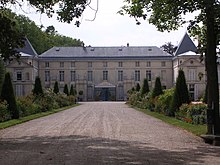Château de Malmaison
The Château de Malmaison (French pronunciation: [ʃɑ.to də‿mal.mɛzɔ̃]) is a country house (or château) in the city of Rueil-Malmaison about 12 km (7 mi) from Paris.

It was formerly the residence of Joséphine de Beauharnais. With the Tuileries it was the headquarters of the French government from 1800 to 1802.
History
changeJoséphine de Beauharnais bought the manor house in April 1797 for herself and her husband, General Napoléon Bonaparte. The future Napoléon I of France was at that time away fighting the Egyptian Campaign. Malmaison was a run-down estate, seven miles (12 km) west of central Paris that encompassed nearly 150 acres (0.61 km2) of woods and meadows.
When he came back from Egypt, Bonaparte was angry at Joséphine for buying such an expensive house. She had expected him to bring back a lot of money from the Egyptian campaign. She had paid well over 300,000 francs for the house and it needed extensive renovations. She spent a lot of money fixing it. Malmaison would bring great happiness to the Bonapartes. Joséphine's daughter, Hortense would call it "a delicious spot".
Joséphine worked hard to transform the large estate into "the most beautiful and curious garden in Europe. She wanted it to be a model of good cultivation". She located rare and exotic plants and animals to enhance the gardens. Joséphine wrote: "I wish that Malmaison may soon become the source of riches for all [of France]"...
In 1800, Joséphine built a heated orangery large enough for 300 pineapple plants. Five years later she ordered the building of a greenhouse. It was heated by a dozen coal-burning stoves. From 1803 until her death in 1814 she cultivated nearly 200 new plants in France for the first time.
The property became famous for its rose garden. Empress Joséphine had the Belgian artist Pierre-Joseph Redouté (1759–1840) record her roses (and lilies). Prints of these works sell quite well, even today. She created an extensive collection of rose. She gathered plants from her native Martinique and from other places around the world. She grew some 250 varieties of roses. From the foreword to Jardin de la Malmaison (1803):
- You have gathered around you the rarest plants growing on French soil....as we inspect them in the beautiful gardens of Malmaison, an impressive reminder of the conquests of your illustrious husband...
Birds and animals of all sorts began to fill her garden. They were allowed to roam free among the grounds. At the height of her days at Malmaison, Joséphine had the company of kangaroos, emus, black swans, zebras, sheep, gazelles, ostriches, chamois, a seal, antelopes and llamas to name a few. Some were from the Baudin expedition.
After her divorce from Napoléon, Joséphine received Malmaison in her own right, along with a pension of 5 million francs a year, and remained there until her death in 1814. After his defeat at the Battle of Waterloo in 1815 Napoléon returned to the house before his exile to the island of Saint Helena.
In 1842 Malmaison was purchased by Maria Christina, widow of King Ferdinand VII of Spain; she lived there with her second husband Agustín Fernando Muñoz, 1st Duke of Riánsares. In 1861 Maria Christina sold the property to Napoleon III.
Malmaison has been restored by the French famous architect Pierre Humbert in the early 20th century.
Present times
changeThe public can visit the manor house as a Napoleonic musée national. The museum lies on RN 13 (route nationale 13) from Paris and bus 258 from RER A "Grande Arche" station.
Gallery
changeExterior
change-
View of the southwest facade of the Manor House
-
Main entrance in the Manor House
-
Pavillon Osiris in the Garden of Malmaison
-
View of the main entrance and the main facade (northeast)
Interior
change-
Chamber of Napoléon
-
Billiard room
-
Music room
-
Joséphine's service - Sèvres porcelain
- Library
-
Library created in 1800 by Charles Percier and Pierre-François-Léonard Fontaine
-
Furniture in mahogany is the creation of the brothers Jacob-Desmalter
-
At the bottom the celestial globe of Nicolas Constant Lemaire dating the 1788
- Apartment of Joséphine
-
Simply decorated anteroom
-
Luxurious chamber of Joséphine de Beauharnais with the bed of origin
-
The wall decoration and the furniture were restored by Napoleon III in 1865
-
Common Chamber in Joséphine's apartment
-
Bed in the Joséphine's common chamber
-
Bathroom in Joséphine's apartment
- Dining room
-
Decoration designed by Charles Percier and Pierre-François-Léonard Fontaine
-
Murals paintings of Louis Lafitte (1800) represent six pompéiennes dancers
-
Dining room
Other websites
change- Official site (in French)
- "Josephine's garden", Orient Express Magazine, Vol. 19, No. 1, by HRH Princess Michael of Kent Archived 2008-09-06 at the Wayback Machine.